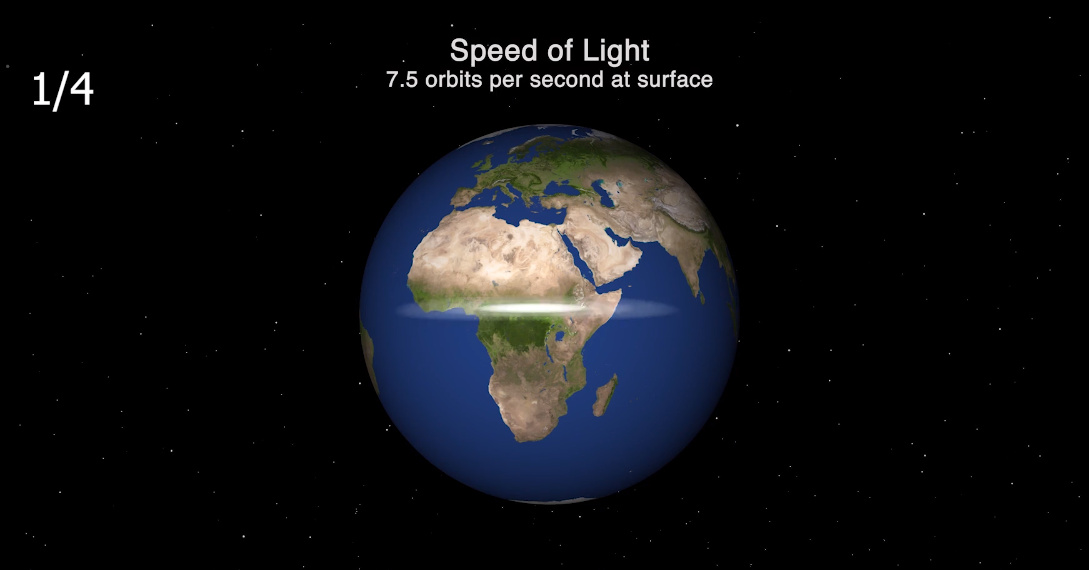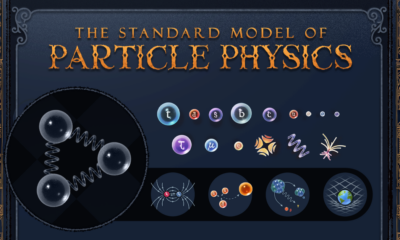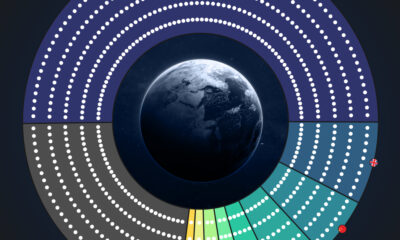Misc
Visualizing the Speed of Light (Fast, but Slow)
Visualizing the Speed of Light
With the flip of a switch, your room can be instantenously flooded with brightness.
In fact, there is no noticeable lag effect at all.
That’s because emitted photons travel at 186,000 miles (300,000 km) per second, meaning it takes only 1/500,000th of a second for light to reach even the furthest part of an ordinary room. And, if it could go through the wall, it would orbit the entire planet 7.5 times in just one second.
Light Speed is Fast…
In our every day experiences, we never see light as having to “take time” to do anything. It’s inconceivably fast, brightening up everything in its path in an instant — and with a few odd caveats, scientists believe light speed to be the fastest-known achievable pace in the universe.
But what if we get out of our bubble, and look at light from outside the confines of life on Earth?
Today’s animation, which comes from planetary scientist Dr. James O’Donoghue, helps visualize the speed of light in a broader context. It helps remind us of the mechanics of this incredible phenomenon, while also highlighting the vast distances between celestial bodies — even in our small and insignificant corner of the solar system.
Light Speed is Slow…
Once a photon is sent into the vast abyss, suddenly the fastest possible speed seems somewhat pedestrian.
- Moon: It takes about 1.255 seconds for light to get from Earth to the moon.
- Mars: Mars is about 150x further than the moon — about 40 million miles (54.6 million km) in the closest approach — so it takes 3 minutes to get there from Earth.
- Sun: The sun is 93 million miles (150 million km) away, meaning it takes 8 minutes to see its light.
Let that sink in for a moment: the sun could explode right now, and we wouldn’t even know about it for eight long minutes.
Going Further, Taking Longer
If it takes light a few minutes to get to the closest planets, how long does it take for light to travel further away from Earth?
- Jupiter: The largest planet is 629 million km away when it’s closest, taking light about 35 minutes.
- Saturn: The ringed planet is about as twice as far as Jupiter, taking light 71 minutes.
- Pluto: It takes about 5.5 hours for light to go from Earth to the dwarf planet.
- Alpha Centauri: The nearest star system is 4.3 light years away, or 25 trillion miles (40 trillion km).
- Visible stars: The average distance to the 300 brightest stars in the sky is about 347 light years.
If you really want to get the feeling of how “slow” light really is, watch the below video and journey from the sun to Jupiter. It’s done in real-time, so it takes about 43 minutes:
So while light obviously travels at a ludicrous speed, it really depends on your vantage point.
On Earth, light is instantaneous – but anywhere else in the universe, it’s pretty inadequate for getting anywhere far (especially in contrast to the average human lifespan).
VC+
VC+: Get Our Key Takeaways From the IMF’s World Economic Outlook
A sneak preview of the exclusive VC+ Special Dispatch—your shortcut to understanding IMF’s World Economic Outlook report.

Have you read IMF’s latest World Economic Outlook yet? At a daunting 202 pages, we don’t blame you if it’s still on your to-do list.
But don’t worry, you don’t need to read the whole April release, because we’ve already done the hard work for you.
To save you time and effort, the Visual Capitalist team has compiled a visual analysis of everything you need to know from the report—and our VC+ Special Dispatch is available exclusively to VC+ members. All you need to do is log into the VC+ Archive.
If you’re not already subscribed to VC+, make sure you sign up now to access the full analysis of the IMF report, and more (we release similar deep dives every week).
For now, here’s what VC+ members get to see.
Your Shortcut to Understanding IMF’s World Economic Outlook
With long and short-term growth prospects declining for many countries around the world, this Special Dispatch offers a visual analysis of the key figures and takeaways from the IMF’s report including:
- The global decline in economic growth forecasts
- Real GDP growth and inflation forecasts for major nations in 2024
- When interest rate cuts will happen and interest rate forecasts
- How debt-to-GDP ratios have changed since 2000
- And much more!
Get the Full Breakdown in the Next VC+ Special Dispatch
VC+ members can access the full Special Dispatch by logging into the VC+ Archive, where you can also check out previous releases.
Make sure you join VC+ now to see exclusive charts and the full analysis of key takeaways from IMF’s World Economic Outlook.
Don’t miss out. Become a VC+ member today.
What You Get When You Become a VC+ Member
VC+ is Visual Capitalist’s premium subscription. As a member, you’ll get the following:
- Special Dispatches: Deep dive visual briefings on crucial reports and global trends
- Markets This Month: A snappy summary of the state of the markets and what to look out for
- The Trendline: Weekly curation of the best visualizations from across the globe
- Global Forecast Series: Our flagship annual report that covers everything you need to know related to the economy, markets, geopolitics, and the latest tech trends
- VC+ Archive: Hundreds of previously released VC+ briefings and reports that you’ve been missing out on, all in one dedicated hub
You can get all of the above, and more, by joining VC+ today.
-

 Mining1 week ago
Mining1 week agoGold vs. S&P 500: Which Has Grown More Over Five Years?
-

 Markets2 weeks ago
Markets2 weeks agoRanked: The Most Valuable Housing Markets in America
-

 Money2 weeks ago
Money2 weeks agoWhich States Have the Highest Minimum Wage in America?
-

 AI2 weeks ago
AI2 weeks agoRanked: Semiconductor Companies by Industry Revenue Share
-

 Markets2 weeks ago
Markets2 weeks agoRanked: The World’s Top Flight Routes, by Revenue
-

 Countries2 weeks ago
Countries2 weeks agoPopulation Projections: The World’s 6 Largest Countries in 2075
-

 Markets2 weeks ago
Markets2 weeks agoThe Top 10 States by Real GDP Growth in 2023
-

 Demographics2 weeks ago
Demographics2 weeks agoThe Smallest Gender Wage Gaps in OECD Countries














